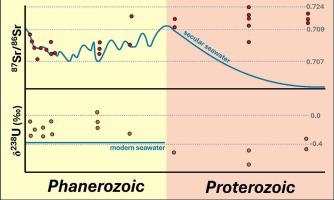当前位置:
X-MOL 学术
›
Chem. Geol.
›
论文详情
Our official English website, www.x-mol.net, welcomes your feedback! (Note: you will need to create a separate account there.)
Reconstructing the depositional environment and diagenetic modification of global phosphate deposits through integration of uranium and strontium isotopes
Chemical Geology ( IF 3.6 ) Pub Date : 2024-06-12 , DOI: 10.1016/j.chemgeo.2024.122214 Robert C. Hill , Zhen Wang , Gordon D.Z. Williams , Victor Polyak , Anjali Singh , Michael A. Kipp , Yemane Asmerom , Avner Vengosh
Chemical Geology ( IF 3.6 ) Pub Date : 2024-06-12 , DOI: 10.1016/j.chemgeo.2024.122214 Robert C. Hill , Zhen Wang , Gordon D.Z. Williams , Victor Polyak , Anjali Singh , Michael A. Kipp , Yemane Asmerom , Avner Vengosh

|
The geochemistry of phosphate rocks can provide valuable information on their depositional environment and the redox condition of global oceans through time. Here we examine trace metal concentrations and uranium (δU, δU) and strontium (Sr/Sr) isotope variations of marine sedimentary phosphate rocks and the phosphate-bearing carbonate fluorapatite (CFA) mineral phase, originating from Precambrian to mid-Miocene aged major global phosphate deposits. We find elevated concentrations of several trace elements (Al, V, Cr, Cd, U, Mn, Co, Cu, As, and Rb) in the CFA mineral phase of young phosphate rocks (Miocene to Late Cretaceous) relative to those of older (Devonian to Precambrian) rocks. The δU of phosphate rocks of Mid-Miocene to Permian age range from −0.311‰ to 0.070‰, exhibiting a positive fractionation relative to modern seawater (−0.38‰). This is similar to the isotope fractionation reported for carbonate and shale sediments, likely resulting from the reduction of uranium in porewaters during CFA precipitation. Cambrian to Precambrian phosphate rocks have lower δU of −0.583‰ to −0.363‰, indicating different depositional redox conditions likely resulting from seafloor anoxia and/or diagenetic modification. The Sr/Sr ratios of phosphate rocks of Cretaceous to Mid-Miocene age generally follow the secular Sr/Sr seawater curve. Phosphate rocks with Sr/Sr that deviate from this curve have characteristic trace metal trends, such as lower Sr/Ca and Sr concentrations, suggesting later diagenetic modification. Older phosphate rocks of Precambrian age are systematically more radiogenic than the expected secular Sr seawater composition at the time of deposition, possibly due to the greater influence of terrestrial input in peritidal zones and/or more pervasive diagenetic modification. Overall, our study reveals connections between U and Sr isotope variations for reconstructing the depositional and diagenetic conditions of global phosphate rock formation through Earth history and the transition to an oxic ocean following the Paleozoic Oxygenation Event.
中文翻译:

通过铀和锶同位素整合重建全球磷酸盐矿床的沉积环境和成岩作用
磷酸盐岩的地球化学可以提供有关其沉积环境和全球海洋随时间变化的氧化还原条件的宝贵信息。在这里,我们研究了海洋沉积磷酸盐岩和含磷碳酸盐氟磷灰石 (CFA) 矿物相的痕量金属浓度以及铀 (δU、δU) 和锶 (Sr/Sr) 同位素变化,这些矿物相起源于前寒武纪至中中新世,年龄主要为全球磷酸盐沉积物。我们发现,与较古老的磷矿相比,年轻磷矿(中新世至晚白垩世)的 CFA 矿物相中几种微量元素(Al、V、Cr、Cd、U、Mn、Co、Cu、As 和 Rb)的浓度升高(泥盆纪到前寒武纪)岩石。中中新世至二叠纪磷酸盐岩的δU值范围为-0.311‰至0.070‰,相对于现代海水(-0.38‰)表现出正分馏。这与报道的碳酸盐和页岩沉积物的同位素分馏类似,可能是由于 CFA 沉淀过程中孔隙水中铀的减少造成的。寒武纪至前寒武纪磷酸盐岩的δU较低,为-0.583‰至-0.363‰,表明可能由于海底缺氧和/或成岩作用改变而导致不同的沉积氧化还原条件。白垩纪至中中新世磷矿的Sr/Sr比值总体遵循长期Sr/Sr海水曲线。偏离该曲线的 Sr/Sr 磷酸盐岩石具有特征性的痕量金属趋势,例如较低的 Sr/Ca 和 Sr 浓度,表明后来的成岩作用改变。 前寒武纪较古老的磷酸盐岩比沉积时预期的长期锶海水成分更具放射性,这可能是由于潮间带陆地输入的影响更大和/或更普遍的成岩作用所致。总体而言,我们的研究揭示了 U 和 Sr 同位素变化之间的联系,用于重建地球历史中全球磷矿形成的沉积和成岩条件以及古生代氧化事件后向含氧海洋的转变。
更新日期:2024-06-12
中文翻译:

通过铀和锶同位素整合重建全球磷酸盐矿床的沉积环境和成岩作用
磷酸盐岩的地球化学可以提供有关其沉积环境和全球海洋随时间变化的氧化还原条件的宝贵信息。在这里,我们研究了海洋沉积磷酸盐岩和含磷碳酸盐氟磷灰石 (CFA) 矿物相的痕量金属浓度以及铀 (δU、δU) 和锶 (Sr/Sr) 同位素变化,这些矿物相起源于前寒武纪至中中新世,年龄主要为全球磷酸盐沉积物。我们发现,与较古老的磷矿相比,年轻磷矿(中新世至晚白垩世)的 CFA 矿物相中几种微量元素(Al、V、Cr、Cd、U、Mn、Co、Cu、As 和 Rb)的浓度升高(泥盆纪到前寒武纪)岩石。中中新世至二叠纪磷酸盐岩的δU值范围为-0.311‰至0.070‰,相对于现代海水(-0.38‰)表现出正分馏。这与报道的碳酸盐和页岩沉积物的同位素分馏类似,可能是由于 CFA 沉淀过程中孔隙水中铀的减少造成的。寒武纪至前寒武纪磷酸盐岩的δU较低,为-0.583‰至-0.363‰,表明可能由于海底缺氧和/或成岩作用改变而导致不同的沉积氧化还原条件。白垩纪至中中新世磷矿的Sr/Sr比值总体遵循长期Sr/Sr海水曲线。偏离该曲线的 Sr/Sr 磷酸盐岩石具有特征性的痕量金属趋势,例如较低的 Sr/Ca 和 Sr 浓度,表明后来的成岩作用改变。 前寒武纪较古老的磷酸盐岩比沉积时预期的长期锶海水成分更具放射性,这可能是由于潮间带陆地输入的影响更大和/或更普遍的成岩作用所致。总体而言,我们的研究揭示了 U 和 Sr 同位素变化之间的联系,用于重建地球历史中全球磷矿形成的沉积和成岩条件以及古生代氧化事件后向含氧海洋的转变。












































 京公网安备 11010802027423号
京公网安备 11010802027423号